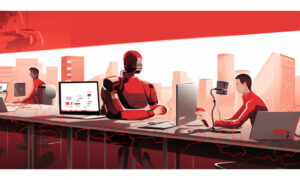Creating a more meaningful working life with continuous performance development: Stuart Hearn, Founder & CEO, Clear Review
- 10 Min Read
In this installment of our HRD Tech Founders Q&A series, Stuart Hearn, Founder & CEO, Clear Review, reveals how a continuous model of employee performance development will slash time invested in performance management, revolutionize employee performance, and create a more meaningful work life for all.
- Author: Michael Hocking
- Date published: Sep 11, 2019
- Categories

What is the true potential of HR and how can technology help us to achieve it?
In this installment of our HRD Tech Founders Q&A series, Stuart Hearn, Founder & CEO, Clear Review, reveals how a continuous model of employee performance development will slash time invested in performance management, revolutionize employee performance, and create a more meaningful work life for all.

What is Clear Review?
Clear Review is a cloud HR technology solution designed to help organisations to move from outdated annual appraisals to a continuous model of employee performance development. In a nutshell, our technology enables businesses and their employees to achieve more, as well as giving employees a more meaningful, rewarding working life. It’s an idea that I conceived after working for many years in HR leadership and consulting roles for organisations such as Sony and United Biscuits.
Why was it necessary to create Clear Review?
Performance management has been around for decades, but organisations have consistently struggled to get it right. The annual appraisal is a case in point. As an HR director I was deeply sceptical about appraisals. They are hugely expensive in terms of time and resource, they are stressful for employees and managers and – because of those barriers, both physical and cognitive – they add very little of value to the business. People generally hate appraisals, they tend to do them in a cursory fashion, and so the data captured by HR is questionable at best. Perhaps most importantly, research shows that annual objective setting followed by a once or twice a year review meeting doesn’t improve employee performance, which should be the ultimate aim of performance management.
There was an excellent piece of research published by Deloitte around the time that I was designing the framework for Clear Review, which showed they were spending 2 million man-hours a year on performance management. At the end of this long, laborious and widely resented process, the business had virtually nothing of value to help them plan the development of their people. I wanted to be able to go to HR directors and CEOs and say “We can give you a simple, elegant and intuitive piece of tech that will genuinely help your managers and employees to develop better relationships, align personal goals with organisational goals, and demonstrate clear and continuous improvement.”
That’s Clear Review. If you want to improve people’s performance, you need meaningful and measurable goals aligned to broader business objectives. You discuss progression toward them with regular, future-focussed performance discussions between manager and employee. And you offer regular, in-the-moment feedback, both positive and constructive, to maintain clarity and fine-tune performance. People develop stronger relationships. They understand how they contribute to business goals. They communicate with more candour and learn to give and receive feedback in a more constructive way.
Why is HR technology crucial to the success of a business?
Leaving aside core HR functions – things like payroll, expenses and so on – the reason that technology is so crucial to an area like performance management is the framework it provides for behavioural change.
Your working life is packed with cognitive barriers. We often refer to the behavioural model developed by Dr. B.J. Fogg, who founded the Stanford Behavior Design Lab. If you want to change behaviour you need three things: the ability (or capability) to do something; the motivation or desire to do it; and the triggers to prompt the action. If you’re missing one of these, the behaviour change won’t happen.
This is the edge that good technology offers to organisations: it provides those in-the-moment triggers which then embed a new behaviour. When we were building Clear Review, we spent a huge amount of time thinking about how to make things simple. That, for me, is so often the mark of great technology: it’s complex and powerful under the hood, but the front end – the user-facing part – is intuitive, it’s engaging. You can just sit down, plug in and get it. I wanted Clear Review to be a tool that people could use without training. In fact, I was speaking to a customer of ours the other day: the HR director of a London borough council. He was telling us that when they implemented Clear Review, they had budget earmarked to train people on their new performance management technology. Once they started rolling out Clear Review, they realised that the tool was simple enough to use without the training they had planned for. So they shifted their resources into soft skills training, and were able to give people support on how to have more effective development conversations. That fact filled me with joy. This is how I envisaged it working: where the tech acts as a framework for better human interaction. Those one-to-one check-ins between manager and employee; the regular feedback; that agile goal-setting: these are the things that move the dial on performance.
How can an organization most effectively implement new HR technology?
There are two big answers to this. The first comes back to the point I was making earlier about simplicity and removing barriers to adoption. The SaaS (Software as a Service) revolution has been a real game-changer for businesses: it’s simpler to trial new tech, it’s faster to roll it out and, as competition has increased, customers have really benefited from better support in terms of customer success. Early on, we made the decision to invest heavily in a customer success team, and the feedback we have from customers really bears this out. We work closely with customers in the rollout phase to help them configure the system exactly the way they want it. For example, organisations have specific terminology that they need to be represented in the system to reflect their culture. HR people may need support in setting up the key metrics they want in their reports and dashboards. Another barrier can be language, so we offer the system in virtually any language, enabling our international clients can use it seamlessly without the language barrier.
But although these hygiene issues are hugely important in giving organisations the calibrated tool they need to capture the right data, the second, and often bigger challenge when implementing HR technology is cultural. In our particular space, many organisations still have that annual appraisal DNA, so they need help with the change management side. The crucial factor in any change is communicating the ‘why’: explaining to people why this change will make their working lives better. We’ve consistently found that the customers who focus on the ‘why’ of the tech as well as the ‘how’, who set up frameworks where people can feed back, who listen to concerns and address the issues head on – these are the organisations who implement in the most effective way.
The mark of success with any new tech, HR or otherwise, is adoption. If people don’t use something then you’ve wasted your money. If you impose something new; if you drop a new tool from the heavens and dictate without explanation, you’re creating challenges that will manifest themselves in disengagement, in people struggling to understand why they’re doing what they’re doing. Take the time to listen. We’ve had customers who’ve rolled out Clear Review in a phased way: they choose the most forward-looking managers and teams to start first, and use those learnings to help other teams implement. That’s not the only way to do it but it’s one good way to overcome resistance: use your tech-savvy employees as the pioneers, listen to their feedback and address it, then use them as advocates within the business. That way you really demonstrate that this is a journey you’re going through with your people, not a new HR directive that everyone has to deal with.
What do you think is the biggest challenge affecting organisations today?
In terms of HR technology, a theme we see again and again is the conflict within companies who have invested in a suite HR solution but are struggling with the shortcomings of some of its modules. Performance management often comes up in this conversation. Above a certain size, it’s very common for us to meet potential customers who are working with an HRIS for Core HR functions, and most of those HRIS suppliers will have a bolt-on performance module. The challenge we then hear about from HR leaders is that the module is either based around the annual appraisal format, which makes it very difficult to implement a continuous model and see those incremental gains we’ve been talking about, or the module’s design can be prohibitively difficult to navigate, which means you lose adoption rates as users struggle to “get on with” the system. Adoption is the part you can’t do without. If people don’t use something then the benefit you were looking for is lost and the opportunity for HR and the board to work with meaningful data is gone.
I completely recognise that it can be a difficult conversation with the FD or CEO. If you’re spending tens of thousands (or, often, much more) on a big HR suite solution, you may not feel justified in going back to the board to ask for more for a specialist bolt-on solution. All I would say is that the ends justify the means. It’s almost impossible to make a transformational change with something that is rooted in legacy thinking, particularly in performance management. You’ll end up fighting the technology while trying to make a cultural change.
Which emerging technologies do you think will transform HR in the future?
The aspect I’m most interested in right now is AI. We’re already seeing AI’s influence in core HR functions like hiring, through applicant tracking, through streamlining the interview process, through advanced analytics. My team and I are interested in looking at ways AI can help in the field of employee performance and development, to both help employees and managers have better outcomes, and for organisations to gain greater insights from the data.
To give you an example of the former, one of the challenges we come across is the difficulty people have in writing good objectives. A big part of the Clear Review framework is based around the setting of meaningful, agile objectives tied to organisational goals. Those objectives need to be specific and measurable, but most people find this hard. We’re looking at ways we can use natural language processing to identify a poorly-written objective and provide automated prompts to help refine them and make them more focused and actionable. I think that’s a great example of using a facet of AI to enhance what is essentially a human process. HR’s focus needs to be people first, and we do need to be sensitive to some of the news around AI: the idea that it’s a threat to jobs, for example. In the context of what we’re doing though, it’s very much a tool that helps people to be better at something they’re doing already.









